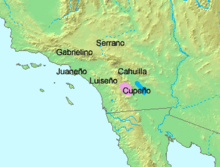Cupeño language
| Cupeño | |
|---|---|
| Kupangaxwicham Pe'memelki | |
| Region | Southern California, United States |
| Ethnicity | Cupeño people |
| Extinct | 1987, with the death of Roscinda Nolasquez |
| Latin | |
| Language codes | |
| ISO 639-3 | |
| Glottolog | cupe1243 |
 |
|
Cupeño is an extinct Uto-Aztecan language, formerly spoken by the Cupeño people of Southern California, United States, who now speak English.
Roscinda Nolasquez (d. 1987) was the last native speaker of Cupeño.
The language was originally spoken in Cupa, Wilaqalpa, and Paluqla, San Diego County, California, and later around the Pala Indian Reservation.
Cupeño is an agglutinative language, where words use suffix complexes for a variety of purposes with several morphemes strung together.
Cupeño inflects its verbs for transitivity, tense, aspect, mood, person, number, and evidentiality.
Evidentiality is expressed in Cupeño with clitics, which generally appear near the beginning of the sentence. =ku'ut 'reportative' (mu=ku'ut 'and it is said that...') =am 'mirative' =$he 'dubitative'
There are two inflected moods, realis =pe and irrealis =e'p.
The pronominals of Cupeño appear in many different forms and structures. The following appear attached only to past-tense verbs.
Future simple verbs are unmarked. Past simple verbs have past-tense pronouns; past imperfect add the imperfect modifier shown below.
/ɛ/ and /o/ appear largely in Spanish loanwords, but also as allophones of /ə/ in native Cupeño words.
/i/ can also be realized as [ɪ] in closed syllables, and [e] in some open syllables.
...
Wikipedia
